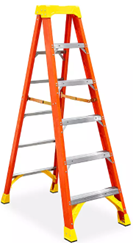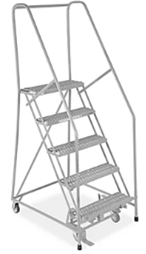Portable Ladder Safety
Ladders are common tools that are found in homes and in the workplace. Given their extensive application, it is not surprising that approximately 20 percent of workplace falls are associated with ladders. Furthermore, about 81 percent of all fall-related injuries necessitating emergency room visits are linked to ladder use. Most falls happen because the wrong type of ladder is selected or the ladder is set up improperly and the ladder shifts or slips unexpectedly.
Ladder Use Training
To minimize the risk of accidents involving ladders, all employees, are required to successfully complete the UC Davis Ladder Safety training module before using ladders for any UC Davis-related work In addition to the online training, each department should provide hands-on training. This will ensure that the appropriate ladder is chosen for each task and that ladders are used safely.
Ladder Selection
Departments must select the proper ladder for the job or task and make them readily available. Here are other considerations when selecting the correct ladder for a particular task:
Select the right ladder design
UC Davis operations utilize various types of ladders. Below are some of the most common types (N.B. This is not an exhaustive list).
Self-supporting Ladders

A-frame step ladder

Rolling staircase ladder
(Safer option to the step ladder)

Step ladder with a safety cage and outriggers
(Safer option to the step ladder)

Orchard ladder
Use on hard surfaces is prohibited. Feet are metal and designed to slightly penetrate firm soil to create secure footing.

Platform ladder
Non-self-supporting Ladders

Shelf, Straight, or Single ladder

Extension ladder
Material Construction
Consider the material the ladder is made of and the environment or hazards the ladder material will be exposed to.
- Wood: electrically nonconductive but can be heavy, rot, splinter, or split if untreated. Wood cannot be painted as it may cover damage, defects, or rot.
- Aluminum: conductive, meaning it is unsafe to use around electricity; lightweight and corrosion-resistant
- Fiberglass: strong, lightweight, and electrically nonconductive as long as there is no fiber bloom. Fiber bloom can be accelerated due to high humidity and exposure to strong sunlight. A blooming ladder, once damp, can conduct up to half the voltage it comes in contact with, causing a conductive chain that could potentially electrocute the handler.
Working Load
Designed for the weight it will hold including:
- Worker’s weight (inc. clothing, footwear, and PPE),
- Weight of tools to be taken on the ladder, and
- Weight of materials to be taken on the ladder.
All ladders must have a legible duty rating sticker.
| Duty Rating | Ladder Type | Working Load (Pounds) |
|---|---|---|
| Special Duty | IAA | 375 |
| Extra Heavy-Duty | IA | 300 |
| Heavy Duty | I | 250 |
| Medium-Duty | II | 225 |
| Light-Duty | III | 200 |
Size and Target Zone
Self-supporting ladders
- The target zone or “safe reaching distance” is typically three to four feet above the ladder when the user is positioned on the highest manufacturer-approved standing level.
Non-self-supporting ladders
- The target zone is typically one foot or less above the top of the ladder when the user is positioned at the highest manufacturer-approved standing level. Cal/OSHA prohibits standing on the top 3 rungs of extension and straight ladders.
- If an upper level must be accessed from the non-self-supported ladder, the ladder must extend at least 3 feet above the upper support point.
- When such an extension is not possible, the ladder must be secured at its top to a rigid support that will not deflect, and a grasping device, such as a grab rail, must be provided to assist employees in mounting and dismounting the ladder.
- When using extension ladders, always maintain at least the minimum required overlap between the ladder sections.


| Ladder Size (Feet) | Minimum Overlap (Inches) |
|---|---|
| Up to and including 32 | 36 |
| Over 32, up to and including 36 | 46 |
| Over 36, up to and including 48 | 58 |
| Over 48, up to and including 60 | 70 |
Ladder Use, Maintenance, and Transportation
Transporting ladders
- Self-supporting ladders tend to open when being carried. Wrapping a cord around the rails near the feet of the ladder can prevent the ladder from opening.
- Assess the load. If the ladder is too heavy, long, or cumbersome, get help and use two people to move it.
- If two people carry a ladder, they should be on the same side of the ladder.
- Prior to lifting the ladder, align your spinal incurves.
- Lift the ladder using your leg muscles.
- Carry the ladder close to your body.
- Keep the front end slightly elevated, especially around blind corners, in aisles, and through doorways.
- Set the ladder down when opening and closing doors.
Prior to set-up
Check the ladder for damage:
- Ladders must be inspected for damage or defects prior to use and after any incident that could affect their safe use. The Portable Ladder Checklist can be used to assist with inspection criteria.
- Never use a damaged ladder.
- If damage or defects are found, remove the ladder from service immediately and tag it as “Danger, do not use.”
- The ladder manufacturer can provide a list of authorized repair facilities. If it cannot be repaired, it should be destroyed before disposal to prevent others from using it.
Ensure stability and secure the work area:
- Find a stable surface and level out uneven ground.
- Do not use ladders on slippery surfaces, or on soft or uneven ground.
- Remove any debris or clutter from around the ladder.
- If the ladder must be set up blocking a door, lock or guard the door.
- Never place ladders on boxes, barrels, or other materials to make it taller.
- Consider traffic (vehicles, scooters/bikes, and pedestrians) around the ladder and act to protect the set-up.
- Check for hazards during set-up, such as power lines, nails, beams, or sharp edges.
Ladder set-up
Self-supporting ladders
- Always open the ladder all the way and ensure the spreader assembly is fully extended and in the locked position prior to use.
- Never use a self-supporting ladder closed against a wall. Instead select a non-self-supporting ladder for the task or purchase a combination ladder that is designed to be used in both the closed and open position.

Non-self-supporting ladders
- When setting up a non-self-supporting ladder, a 4:1 ratio of the ladder’s working length to the base distance is needed. The working length is the portion of the ladder from the bottom of the ladder contacting the ground to the upper-support point.
For example, if the ladder has a 20-foot working length from the ground/base to the upper support point, the user will divide 20 by 4 to get the base distance of 5 feet.

Using ladders
- Face the ladder when ascending, descending, and performing work.
- Maintain 3 points of contact (both feet and one hand or both hands and one foot).
- Climb the ladder holding the rungs, not the side rails.
- Do not overreach, jump or walk the ladder. Take the time to move the ladder when needed.
- Stay centered using the “belt buckle rule”: Keep your belt buckle between the side rails. Never reach where your buckle goes outside of the rails.
- Use tool belts or ropes attached to buckets to bring tools up.
- Do not overload the ladder. Check the ladders load rating.
- Know the highest ladder rung that can be used to stand on, and do not stand on prohibited steps. Review the manufacturer’s manual for ladder-specific information.
- When descending, look down to ensure you do not miss the last rung before stepping off the ladder.

Storing ladders
- Store your ladder in a well-ventilated area away from heat sources.
- Store wood and fiberglass ladders away from excessive moisture, humidity, and sunlight.
- Keep your ladders away from corrosive materials.
- Store self-supporting ladders in a closed position, orientated vertically to reduce the risk of sagging or twisting.
- Secure vertically stored ladders using cords, straps, wall brackets, or racks to prevent them from tipping over or creating a trip hazard.
- Store non-self-supporting ladders in flat racks or on a sufficient number of wall brackets that will prevent them from sagging.
- Don’t store materials on ladders.
- See the manufacturer’s manual to determine how the ladder should be stored (vertically, horizontally
Maintaining ladders
- A competent person must perform maintenance.
- Keep the ladder free from mud, grease, or other substances.
- Clean and lightly lubricate moving parts.
- Ensure all labels are in place and legible. If the labels are missing or illegible, the ladder must be removed from service until they can be replaced.
- Remove damaged ladders from service and label them “Danger, do not use.”
- The ladder manufacturer can provide a list of authorized repair facilities. If it cannot be repaired, it should be destroyed before disposal to prevent others from using it.
Reference the Cal/OSHA Portable Ladder Safety eTool for additional ladder inspection, use, and maintenance tips.